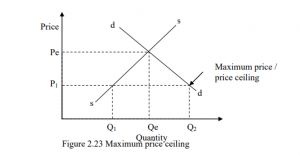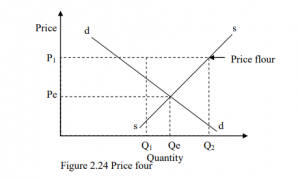This refers to a deliberate action by the government to artificially impose through legislation the prices of certain goods and services. Such imposed prices are referred to as flat prices. These flat prices may be a maximum or a minimum price. A maximum price refers to that price above which a good or a service cannot be sold. A minimum price refers to that price below which a good/service cannot be sold. The government may find it necessary to control the prices of certain good/service because:
- Cheapness It may be objective of the government to keep price of certain goods and services at a level at which they can be afforded by most people hence protecting the consumer being exploited by producers
- Maintenance of income. The government may want to keep the income of certain producers at a higher level than that which would be supplied by market forces demand and supply. Thus the government is able to maintain the low income producers in the market.
- Price stability if there is a wide variation in the price of product year to year the government may wish to iron out these variations for the interests of both producers and consumers. This price control will act as one of the methods to
curb inflation.
Maximum price control/price ceiling
Consider Figure 2.23, if the government imposes a price ceiling, given by P1 there will an excess demand or shortage equivalent to Q2- Q. Under normal circumstances this economic force of excess demand will exert an upward pressure prices. However, in this case the price cannot go above P1, since P1 is the maximum price. This price is unable to fulfill the rationing function leading to a demand for a centrally administered system of rationing of the good in question.

Other effects of Price controls
- Rise of black market where goods are sold above legal price even above the equilibrium price.
- Shortages are likely to become chronic as producers move away from production of price controlled goods.
- Research and development will be encouraged as the producers move from the price controlled industry.
- There will be increased costs efficiency in production by firms as profits can only be increased by reducing costs.
Minimum price/price floor
This refers to the action taken by the government to set a price below which a good/service cannot be sold. They are normally imposed above the equilibrium price since the government feels that the price determined by forces of demand and supply is too low as illustrated in Figure 2.24
If the government imposes a minimum price by P1, the immediate effect will be surplus given by Q1 Q2. Under normal circumstances excess supply exerts a down ward pressure on prices, but in this case prices cannot go below P1 for it is a minimum price. The
government then has to intervene by buying excess stock or limiting it to prevent prices from going down.

Other effects of price floors
- In the case of a minimum produce price floor, (low income producers) will have a stabilizing effect on their income.
- In the case of minimum wages employed workers will be guaranteed an income compatible with the cost of living.
- Some producers may be wiling to dispose off their product below the minimum legal prices especially in the case of labour.
- In the case of minimum wage rate, it will lead to reduction in employment.
Advantages of price control
- Protects consumers, especially the low income consumers from price increases by producers.
- Ensures that producers have a reasonable income which is subject to inflation
- Contributes to industrial peace especially if they constitute part of the comprehensive income policy and a maximum price is fixed on some basic goods.
- It may be associated with a decrease in price and an increase in output such as the case of a monopolist overcharging for its products and is forced to lower prices. In this case the monopolist may accompany the fall in price with an increase in output in order to compensate for loss in revenue.
- It may be used as one of the several counters of inflation
